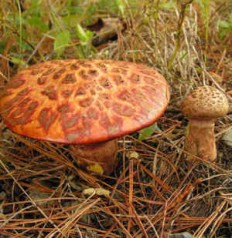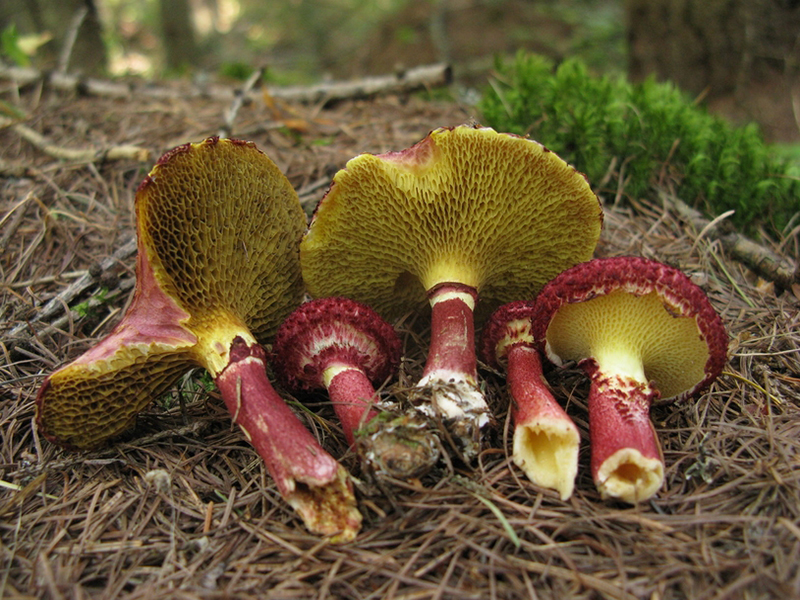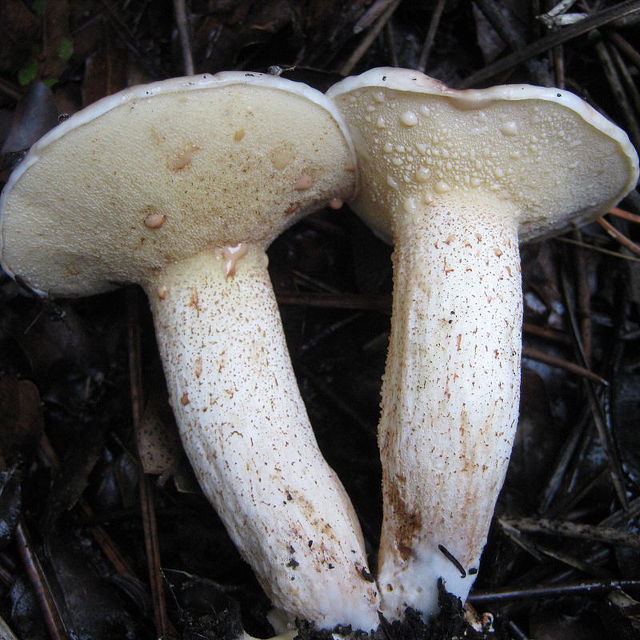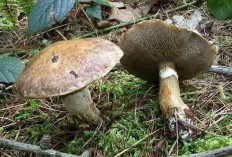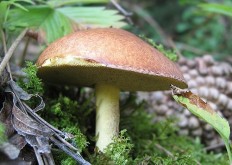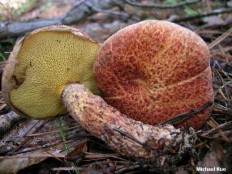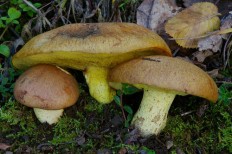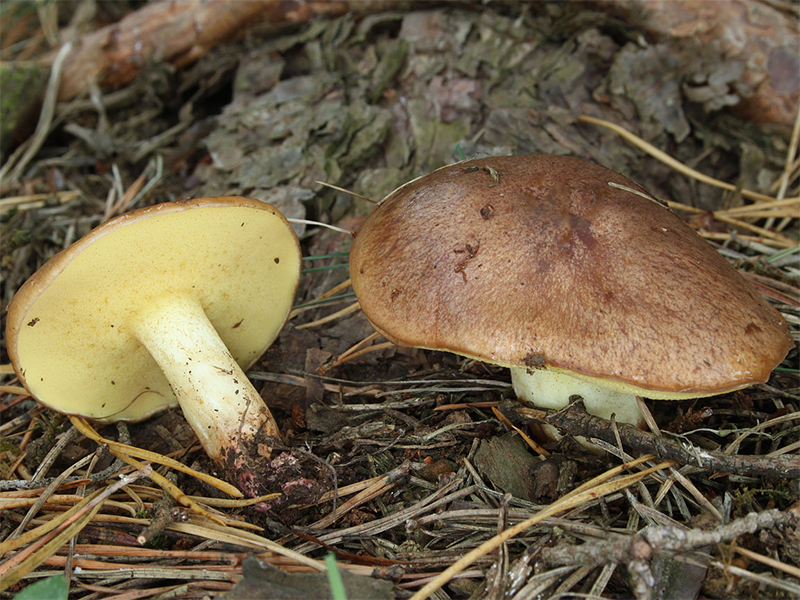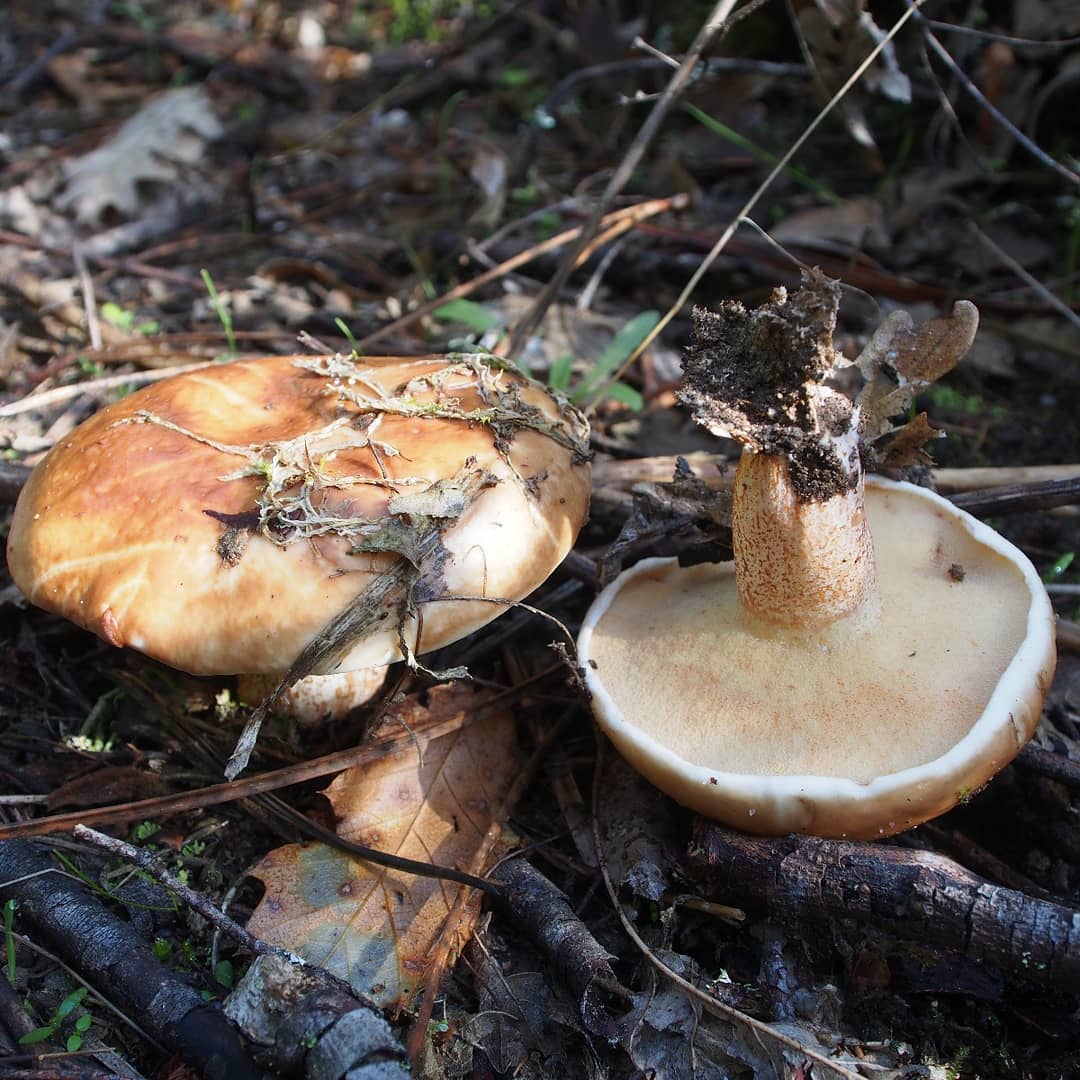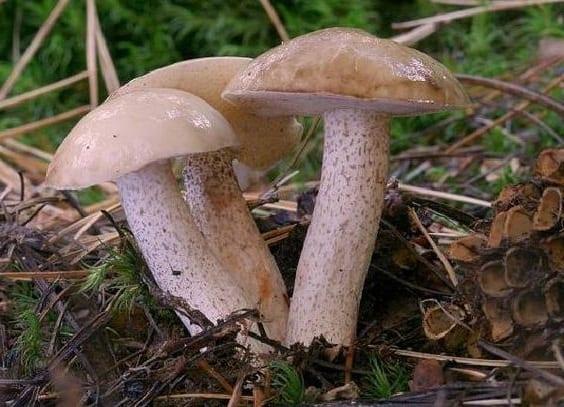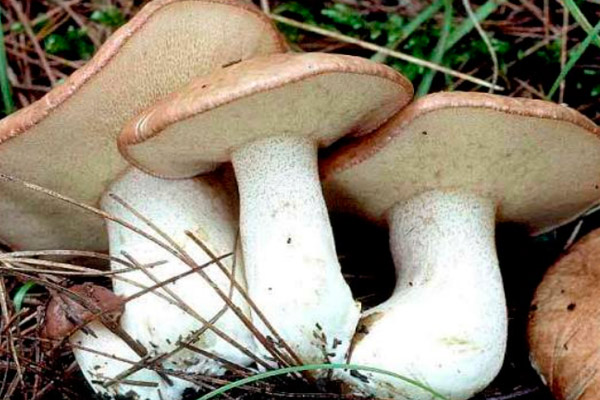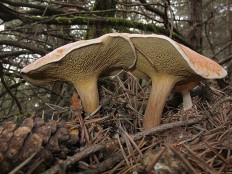Bellini Butter Can
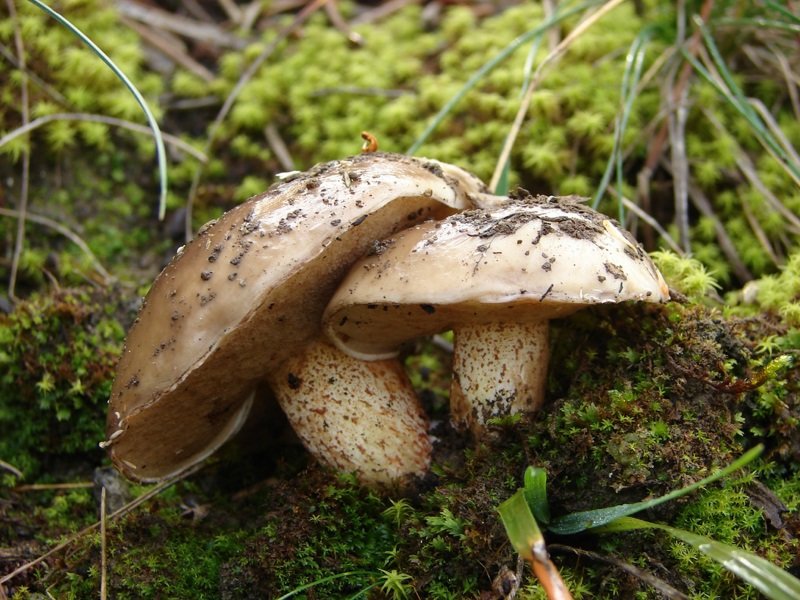
Bellini butter dish (Suillus bellini)
- Boletus bellinii;
- Rostkovites bellinii;
- Ixocomus bellinii.
The Bellini Butter (Suillus bellini) is a mushroom belonging to the Suillaceae family and the Oiler genus.
External description of the mushroom
Bellini butter dish (Suillus bellini) consists of a leg and a cap with a diameter of 6 to 14 cm, brown or white in color, with a smooth surface. In a young mushroom, the cap has a hemispherical shape; as it ripens, it becomes convex-flattened. In the central part, the cap is slightly darker in color. Hymenophore is greenish-yellow in color, short-length tubes with angular pores.
The stem of the fungus is characterized by a short length, massiveness, whitish-yellow tint and parameters 3-6 * 2-3 cm, covered with granules from reddish to brownish color, towards the base of the stem of this species it becomes thinner and curved. Fungal spores have an ocher hue and are 7.5-9.5 * 3.5-3.8 microns in size. There is no ring between the leg and the cap, the flesh of the Bellini Butter Dish is whitish in color, at the base of the leg and under the tubes it may be yellowish, has a pleasant taste and strong aroma, and is very tender.
Habitat and fruiting period
A mushroom called Bellini Butter (Suillus bellini) prefers to live in coniferous or pine forests, while not imposing special requirements on the composition of the soil. It can grow both singly and in groups. Fruiting of the fungus occurs only in the fall.
Similar species, distinctive features from them
The species of mushrooms similar to Bellini's oil can are the edible varieties in the form of granular oil can and autumn oil can, as well as the inedible species - Suillus mediterraneensis.
All species of the genus Oiler:
| White butter dish (Suillus placidus) | Greyhound (Suillus viscidus) | Oiler (Suillus cavipes) |
| Asian butter dish (Suillus asiaticus) | Marsh butter dish (Suillus paluster) | Bellini butter dish (Suillus bellinii) |
| Goat (Suillus bovinus) | Clinton's Butter Dish (Suillus clintonianus) | Yellowish butter dish (Suillus flavidus) |
| Granular butter dish (Suillus granulatus) | Larch Butter (Suillus grevillei) | Common butter dish (Suillus luteus) |
| Cedar Butter (Suillus plorans) | Siberian butter dish (Suillus sibiricus) | Yellow-brown butter dish (Suillus variegatus) |
| Sour butter dish (Suillus acidus) | Cedar punctipes butter dish (Suillus punctipes) | Sprague's Butter Dish (Suillus spraguei) |
| Trentian Butter (Suillus tridentinus) | Non-ringed butter dish (Suillus collinitus) |
If you are in doubt about the edibility of the mushrooms you find, do not take them. The site administration does not bear any responsibility for the actions of people taken on the basis of the information received on the site. Some types of poisonous mushrooms cannot be identified without special equipment and can be confused with edible ones.
Sprague's butter dish (Latin Suillus spraguei)
Name Sprague's Butter Dish.Latin name: Suillus spraguei.Other names: Painted Boletinus, Painted Sieve, Painted Oiler.Department: Basidiomycota.Class: Agaricomycetes.Order: Boletovye.Family: Oil cans.Genus: Oiler.Edible mushroom.
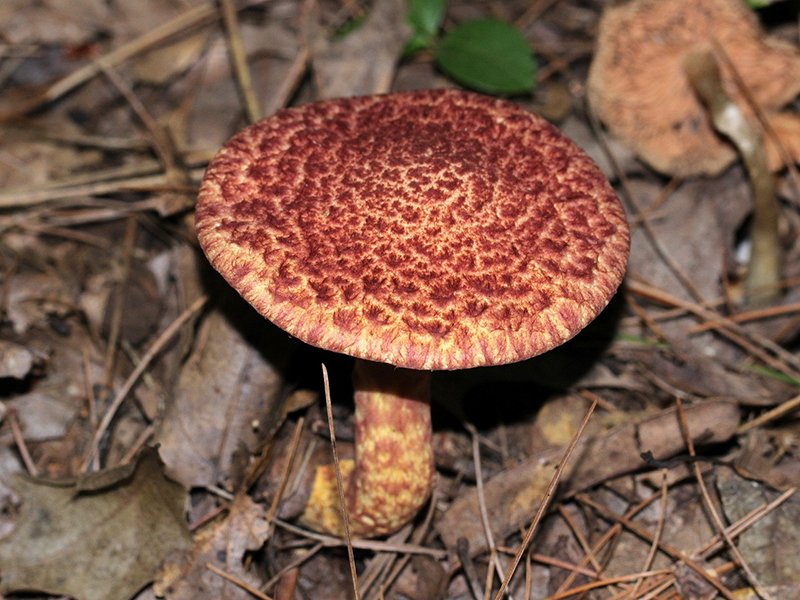 Name Sprague's Butter Can.Latin name: Suillus spraguei.Other names: Painted Boletinus, Painted Sieve, Painted Oiler.Department: Basidiomycota.Class: Agaricomycetes.Order: Boletovye.Family: Oil cans.Genus: Oiler.Edible mushroom.
Name Sprague's Butter Can.Latin name: Suillus spraguei.Other names: Painted Boletinus, Painted Sieve, Painted Oiler.Department: Basidiomycota.Class: Agaricomycetes.Order: Boletovye.Family: Oil cans.Genus: Oiler.Edible mushroom.
Leg
35-110 mm long, 10-30 mm thick, cylindrical, not hollow, sometimes thickened at the base, the color is the same as the cap, there is a fibrous ring that can disappear over time, leaving a clear border between the upper part without scales, and the lower one with scales ...
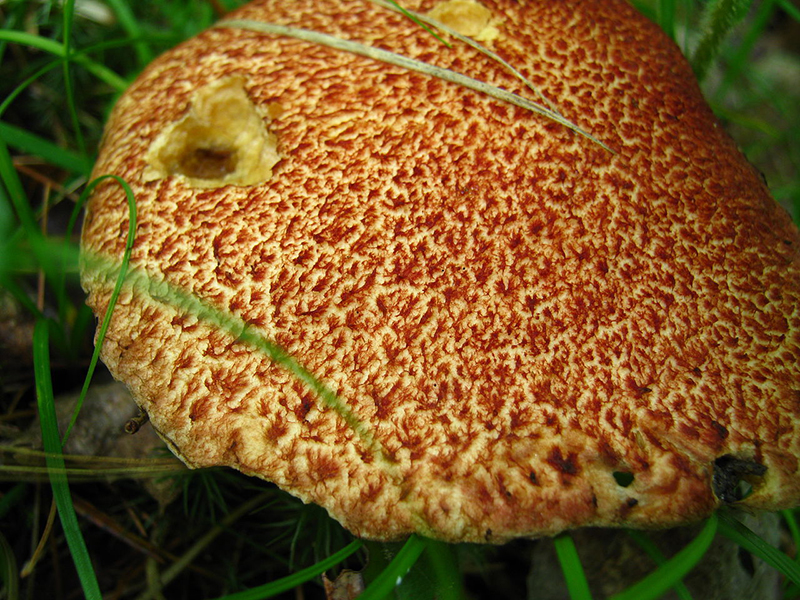
Hat
35–125 mm in diameter, conical in young fruiting bodies, the edge with scraps of filiform private veil, as the fruiting body matures, it develops into an open, light yellow, dark yellow color with red-brown, red flaky scales. The skin is dry, slightly sticky when moist.
Hymenophore
Tubular, descending along the leg, yellow, eventually turns yellow-brown.The pores are rounded, radially elongated, of the same color as the tubules; if damaged, they turn brown. In young fruits, it is covered with a fibrous private veil of white color.
Pulp
Light yellow, yellow, dense, when damaged it turns pink and red, the taste is pleasant, mushroom, the smell is pronounced, pleasant. Likewise, the taste can be characterized according to some sources as unpleasantly sour.
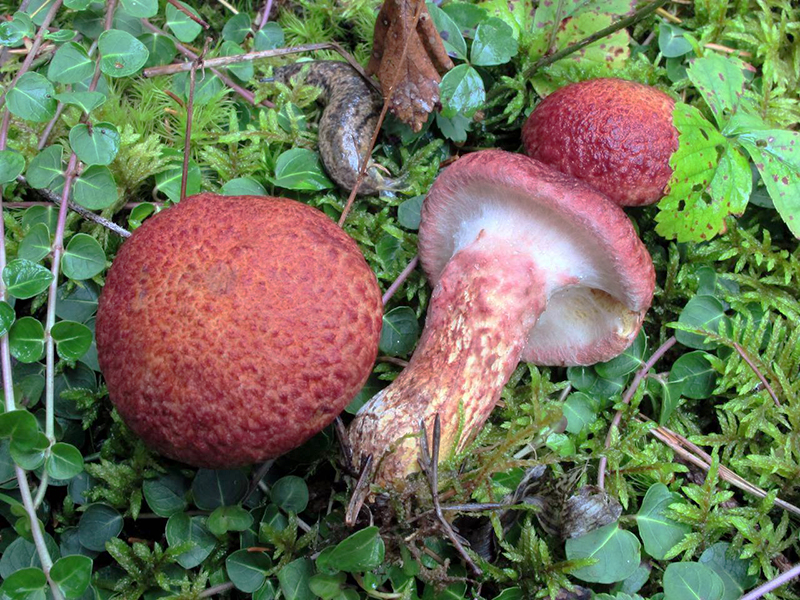
Habitat
They grow on the ground singly or in groups in coniferous or mixed forests. Forms mycorrhiza with pines of various types, more often with cedar pine.
Additionally
The fruit body is often parasitized by Hypomyces completus, appearing in small patches of white mold on the stem or cap of the fungus, then quickly spreading throughout the fruit body.
Similarity
It is similar to the Asiatic Butter (Suillus asiaticus), which has a hollow stem.
|
December |
January |
February |
|
March |
April |
May |
|
June |
July |
August |
|
September |
October |
November |
Butter dish (Suillus luteus)
- Other names for the mushroom:
- Real butter dish
- Ordinary butter dish
- Butter dish yellow
- Autumn butter dish
Synonyms:
- Boletus luteus
- Boletopsis lutea
Late butter dish (Suillus luteus) is the scientific name for the most common type of butter oil. The word luteus in the scientific name of the mushroom means "yellow".
Growth:
Late oil can grow on sandy soil from late May to November in coniferous forests. Fruiting bodies appear singly or most often in large groups.
External description
Hat:
The cap of the present Oily (Suillus luteus) reaches a diameter of up to 10 cm, convex, later almost flat with a tubercle in the middle, sometimes with upward curved edges, chocolate-brownish, sometimes with a purple tint. The skin is radially fibrous, very slimy and easily separated from the pulp. The tubules are initially pale yellow, later dark yellow, adherent to the peduncle, 6-14 mm long. The pores are small, in young mushrooms pale yellow, later bright yellow, brownish yellow. Tubular layer adherent to the pedicle, yellow, the pores are at first whitish or pale yellow, then yellow or dark yellow, small, rounded.
Leg:
Cylindrical, solid, 35-110 mm high and 10-25 mm thick, lemon-yellow at the top, brownish and longitudinally fibrous at the bottom. A white filmy blanket, which first connects the leg to the edge of the cap, leaves pieces on the leg in the form of a black-brown or purple ring. Above the ring, the leg is mealy.
Pulp:
The cap is soft, juicy, slightly fibrous at the stem, whitish at first, later lemon-yellow, rusty-brownish at the base of the stem.
Spore powder:
Brown.
Spores: 7-10 x 3-3.5 µm, ellipsoid-fusiform, smooth, pale yellow.
Similarity
On Late oiler is very similar to oiler red (Suillus fluryi), which is distinguished by the absence of a ring on the leg. It has no resemblance to poisonous mushrooms.
Use
Late butter dish - Edible, tasty mushroom of the second category, in taste, it is very close to porcini mushrooms. It is better to remove the skin from the cap before use. It is consumed dried, fresh, pickled and salted. Delicious and easily digestible mushroom. Suitable for preparing soups, sauces and side dishes for meat dishes. To be pickled.
Spreading
The optimum average daily temperature for fruiting the oiler is + 15 ... + 18 ° C, but the ordinary oiler does not react strongly to temperature fluctuations. Fruiting bodies of boletus usually appear 2-3 days after rain, and strong dew also stimulates fruiting. In mountainous areas, boletus can grow massively around stones, this is due to the condensation of moisture on the surface of the stone. Fruiting ceases at a temperature of -5 ° C on the surface of the soil, and after freezing of the upper layer by 2-3 cm, it does not resume. In the summer (at the beginning of the season) boletus is often damaged by insect larvae, sometimes the proportion of unsuitable "wormy" boletus reaches 70-80%. In autumn, insect activity decreases sharply.
Late oiler is widespread in the Northern Hemisphere, prefers a moderately cold climate, but is also found in the subtropics, sometimes it is accidentally introduced by humans into tropical regions, where it forms local populations in artificial pine plantations.
In Russia, boletus is widespread in the European part, in the North Caucasus, in Siberia, in the Far East. Fruiting more often in large groups.
Season June - October, massively from September.
Features of the mushroom:
Boletus edulis (boletus) are ahead of boletus edulis in terms of the content of fats and carbohydrates. Late butter dish - One of the most common types of edible mushrooms, it takes first place in its yield in coniferous forests.
Edible oil Bellini
Bellini Butter is an edible mushroom that can be boiled and pickled.
Similar species
Bellini's oiler is similar in appearance to other edible and inedible oils:
• Granular butter dish is an edible mushroom. The hat of the granular oiler is round-convex, 10 centimeters in diameter. Its color is reddish or brown-brown, and over time it becomes yellow-brown. Its surface is practically not sticky, and it seems dry. The length of the leg is 8 centimeters, and the thickness is 1-2 centimeters, its upper part is white, dotted with grains.
Granular oiler grows in pine forests, in places with low grass. The largest quantities of these mushrooms are found in the Caucasus. By taste, granular butter belongs to the 2nd category, they are boiled, salted and pickled;

• Autumn or real butter dish - edible mushroom. The diameter of the cap of the autumn butterdish is 3-14 centimeters. As it grows, its shape changes from hemispherical to flat. The surface of the cap is slimy, smooth, brown or chocolate brown. The peel is easily separated from the cap.
The leg length is 3-11 centimeters. It is longitudinally fibrous, whitish or yellow in color, and becomes dirty purple or black-brown with age.
These mushrooms are widespread in the Northern Hemisphere, preferring a moderately cold climate, but can also be found in subtropical regions. Fruiting from June to October. These are delicious mushrooms of the 2nd category;

• Mediterranean butter dish is an inedible mushroom. Its cap reaches 10 centimeters in diameter. The color of the caps of young mushrooms is pale yellow or honey-yellow, and over time it becomes red-ocher or ocher-brown.
The leg is straight, cylindrical in shape, there is no ring on it. The color of the leg is yellowish, over the entire surface it is covered with a large number of small dots of brownish-yellow color. These mushrooms grow in the pine forests of Israel. They prefer to settle next to the Italian and Jerusalem pine. These mushrooms grow in groups or singly. They bear fruit in the winter months.

Similar types and differences from them
Inedible doubles
Mediterranean butter dish
Unlike the Bellini Butter, the Mediterranean counterpart has a hat with a diameter of no more than 100 mm, which is initially light yellow or honey yellow, and later reddish-ocher or brownish-ocher. The stem of the mushroom does not bend, but remains flat, and is covered with many tiny yellowish - brown specks.
For growth, this fungus chooses Israeli pine forests with Jerusalem and Italian pines. Fruiting of the inedible double occurs in the winter.
Edible doubles
Autumn butter dish (real)
This edible counterpart features a flat hat with a leathery surface that comes off easily. The hat reaches a diameter of 30-140 mm and has a chocolate or brown color. The leg can be extended up to 110 mm. Unlike the tender pulp of the Bellini mushroom, the Real Butter has a leg filled with longitudinal fibers. Closer to old age, it turns dark purple or brown - black.
The autumn buttercup prefers a cool, temperate climate and bears fruit all summer and September, while the Bellini buttercup produces crops only in the autumn months.
Granular oiler
In contrast to the Bellini mushroom with a flatish hat, the granular analogue has a rounded - convex "headdress", the diameter of which does not exceed 100 mm. Its color varies from red-brown to brown-yellow (the older the mushroom, the lighter the hat). In the comparable analogue, the hats are covered with a shiny oily skin, in the granular one - matte and dryish. The white top of the leg, which grows up to 80 mm high and 10-20 mm thick, is covered with small specks.
The granular butter dish chooses pine forests with low grasses for development and fruiting, while the Bellini butter dish is completely unpretentious to soils and terrain: the main thing is that it is a pine forest. Most often, a granular analogue is found on the Caucasian land.
Ruby oil can
Ruby oil can - Latin suillus rubinus
In another way, it is called Rubinoboletus, Ruby Pepper Mushroom, Ruby Halciporus, Ruby Moss or Ruby Mushroom.
Description
Mushroom cap
Ruby pepper mushroom has medium-sized caps that grow from 40 to 80 mm in diameter. In young mushrooms, they are round or hemispherical, in adult specimens, they are half-open or almost flat, cushion-shaped, fleshy, with wavy sharp edges curving upward.
Mushroom "hats" are covered with a dry matte skin that feels like suede. It is painted in brick, yellow - brown, brown - yellow or red - carmine shade. The skin is not removed from the hat surface. In dry weather, it can crack, in rainy season it is usually covered with mucus.
The inside of the hats is filled with yellowish flesh, becoming bright yellow under the skin and pinkish above the tubular layer. When cut, the flesh in the area of the leg does not change its color.
The hat bottom is filled with a tubular mass of tubes of red-pink or carmine tones slightly running down the stem with large pores, which do not change color when pressed and broken.
Ruby butter dish reproduces by buffy round spores that form in a brownish spore powder.
Stipe
Ruby flywheel builds up a low, often curved leg in the form of a club or cylinder, located in the center of the cap and, as a rule, tapering towards the base. The legs are 1.5-3 cm thick and 3-6 cm high.
The smooth foot surface, occasionally pubescent at the base, is dotted with a mesh pattern in the form of tiny granules of carmine or pink color. The base is colored yellow or ocher. The flesh of the leg is pinkish, below it is bright yellow.
Ruby oil can - Latin suillus rubinus
Growing places
Usually Chalciporus ruby grows on the ground, but there are specimens that choose well-decomposed oak wood for development and fruiting.
A rare mushroom, which is on the verge of extinction, prefers oak forests, as well as mixed forests with birch trees, hawthorn, holly, beech, linden, chestnut. Occasionally chooses pine forests with a small amount of deciduous species.
It is found in old parks with floodplain soils. However, most often he chooses an oak forest in which cattle regularly graze, there is a spacious underbrush, a grass cover with forbs and grasses, and fertile soils underlain by silty loam.
Rubinoboletus is often found in European countries, sometimes in the Far East and Transcaucasia, where it grows singly or in groups of two or three mushrooms. Fruiting does not occur every year and, as a rule, falls on a damp warm summer and early autumn. The mushroom produces harvests closer to August and until mid-September.
Edibility
The pulp of Ruby Butter has a weak mushroom aroma or does not smell at all, it is either tasteless or slightly bitter.It belongs to the 2nd category of edibility and is used for pickling, salting, frying and stewing.
But, since the Ruby Mushroom is listed in the Red Book of the Russian Federation, it was assigned a conservation status, so the authorities recommend refraining from collecting it in order to preserve this handsome man and prevent its disappearance.
Due to its specific appearance, the Ruby Butter has no similar species.

